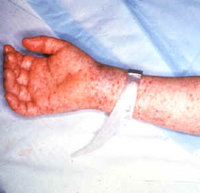Rocky Mountain spotted fever
Rocky Mountain spotted fever is the most severe and most frequently reported rickettsial illness in the United States, and has been diagnosed throughout the Americas. more...
Some synonyms for Rocky Mountain spotted fever in other countries include "tick typhus", "Tobia fever" (Columbia), "São Paulo fever" and "febre maculosa" (Brazil), and "fiebre manchada" (Mexico). The disease is caused by Rickettsia rickettsii, a species of bacteria that is spread to humans by hard ticks (Ixodidae). Initial signs and symptoms of the disease include sudden onset of fever, headache, and muscle pain, followed by development of rash. The disease can be difficult to diagnose in the early stages, and without prompt and appropriate treatment it can be fatal.
Rocky Mountain spotted fever was first recognized in 1896 in the Snake River Valley of Idaho and was originally called "black measles" because of the characteristic rash. It was a dreaded and frequently fatal disease that affected hundreds of people in this area. By the early 1900s, the recognized geographic distribution of this disease grew to encompass parts of the United States as far north as Washington and Montana and as far south as California, Arizona, and New Mexico.
Howard T. Ricketts was the first to establish the identity of the infectious organism that causes this disease. He and others characterized the basic epidemiological features of the disease, including the role of tick vectors. Their studies found that Rocky Mountain spotted fever is caused by Rickettsia rickettsii. This species is maintained in nature by a complex cycle involving ticks and mammals; humans are considered to be accidental hosts and are not involved in the natural transmission cycle of this pathogen. Tragically, Dr. Ricketts died of typhus (another rickettsial disease) in Mexico in 1910, shortly after completing his remarkable studies on Rocky Mountain spotted fever.
The name Rocky Mountain spotted fever is somewhat of a misnomer. Beginning in the 1930s, it became clear that this disease occurred in many areas of the United States other than the Rocky Mountain region. It is now recognized that this disease is broadly distributed throughout the continental United States, as well as southern Canada, Central America, Mexico, and parts of South America. Between 1981 and 1996, this disease was reported from every U.S. state except Hawaii, Vermont, Maine, and Alaska.
Rocky Mountain spotted fever remains a serious and potentially life-threatening infectious disease today. Despite the availability of effective treatment and advances in medical care, approximately 3% to 5% of individuals who become ill with Rocky Mountain spotted fever still die from the infection. However, effective antibiotic therapy has dramatically reduced the number of deaths caused by Rocky Mountain spotted fever; before the discovery of tetracycline and chloramphenicol in the late 1940s, as many as 30% of persons infected with R. rickettsii died.
Read more at Wikipedia.org


